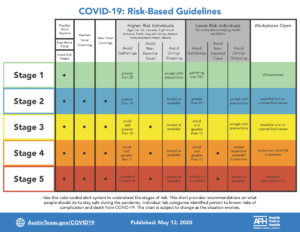As Covid-19 cases spike, local officials stress caution and personal choice in slowing its spread
Tuesday, June 16, 2020 by
Elizabeth Pagano Austin Mayor Steve Adler, Public Health Interim Medical Director Dr. Mark Escott and Assistant to the Travis County Judge Sarah Eckhardt extended stay-at-home orders Monday in response to a surge in Covid-19 cases, and asked residents to reinvest in precautions to help slow the virus’ continued rise.
“This community gets to make this choice,” Adler said. “I hope everybody will work to protect one another.”

On Sunday, Austin’s rolling daily average of hospitalizations rose to 20.6, moving the area into Stage 4. As a result, revised local orders that reflect the new recommendations are now in place until Aug. 15.
“Quite clearly, the situation has changed in Travis County over the past week,” Escott said.
In Stage 4 conditions, Austin Public Health advises high-risk individuals, including people over 65 and those with underlying medical conditions, to avoid going out and to refrain from gatherings of more than two people. In addition, all residents should avoid gatherings of more than 10 people.
“Frankly, we have gotten to this place sooner than I thought that we would,” Adler said. “When this virus comes, it is going to come fast. It is going to come faster than any of us can imagine. … We’re getting that first early warning sign that this virus is still here, that it’s coming at us.”
Because state law supersedes city and county laws, the guidelines discussed Monday can’t be enforced. An order from the governor currently allows restaurants to operate at 75 percent capacity and other businesses to operate at 50 percent capacity.
Despite Gov. Greg Abbott’s open support for wearing protective face coverings, he has remained steadfast in his stance that their use not be mandated. Adler said he is in contact with the governor’s office about allowing local municipalities to require the use of face coverings.
“It just seems like such an important thing to do that is so consistent with and doesn’t interfere with the opening up of the economy,” he said. “But ultimately, the governor will decide what the governor does.”
Updated stay-at-home orders from the city include new language encouraging individuals and businesses to exercise more caution than the current state regulations:
“Despite the issuance of GA-26, local conditions in Travis County continue to exhibit an alarming upward trend of COVID-19 virus transmission and hospitalizations and businesses are encouraged to do everything they can, beyond the requirements of GA-26, to require social distancing and require face masking behaviors while the City remains in Stage 4.”
During the press conference, Adler also “strongly suggested” that businesses reduce to a minimal indoor capacity of 25 percent or below, and continue to offer remote services.
Dr. Escott highlighted the fact that from Sunday to Saturday of last week, the area had 799 new cases diagnosed, representing a 90 percent increase over the previous week. In addition, he noted that the time it took for cases to double leaped from 44 days to 25.5 days. All indicators that Austin Public Health is currently tracking have risen over the the past week, and continue to be tracked on its Covid-19 dashboard.
“Our hospitals are in good shape right now. … We want to make sure that folks, if they need health care, seek health care,” Escott said. “Now is the time to go do those things. Now is the time that we have plenty of hospital capacity. … The conversation today is a concern for what is three or four or five weeks in the future.”
Escott estimated that area hospitals are at about 70 percent occupancy, with a small number of beds dedicated to Covid-19 patients. Modeling shows that there are about 1,100 beds available for Covid-19 patients, though metrics and data are constantly being reevaluated. He noted that there “can be a very short period of time between when the situation is OK and when the hospitals become overwhelmed.”
“The conversation today is about behavior change. It is about what we can do as a community to flatten this curve again. We did a great job in March and April and May to get this flat,” he said. “We need to do that again.”
Adler acknowledged that there is currently a debate that pits the health of the economy against concern about the virus, and deemed it a “false choice.” He emphasized that he wanted people to go out and for businesses to be open, but asked that those who do choose to go out wear masks and maintain a 6-foot distance from others.
“We each need to look into ourselves right now,” Adler said. “We have a virus that is disproportionately going after people who are over 65. It is disproportionately going after people who have preexisting conditions … it is disproportionately going after our communities of color. By the individual choices we make, and what we do over the coming weeks, we get to decide for ourselves how important it is for us to protect those people – our neighbors and our community.”
The Austin Monitor’s work is made possible by donations from the community. Though our reporting covers donors from time to time, we are careful to keep business and editorial efforts separate while maintaining transparency. A complete list of donors is available here, and our code of ethics is explained here.
You're a community leader
And we’re honored you look to us for serious, in-depth news. You know a strong community needs local and dedicated watchdog reporting. We’re here for you and that won’t change. Now will you take the powerful next step and support our nonprofit news organization?










